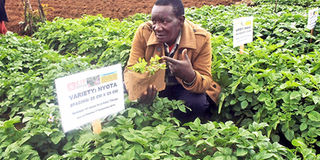Agronomist notebook: How to keep roots healthy for high yield

A farmer displays potato cuttings growing under tissue culture technology during World Food Day celebrations at Gatura Farm in Elburgon. Phosphatic fertilisers help in plant roots' development hence the need to apply them during land preparation. PHOTO | JOHN NJOROGE | NMG
What you need to know:
- Land preparation should adequately be done in advance to allow the weeds to dry up. Also, timely planting is ideal as this facilitates the seeds to germinate and emerge before the weeds grow.
- Sometimes the seedlings wilt and die due to transplanting shock, especially if the roots are not well covered in the soil.
- Sometimes farmers end up cutting the roots, which creates an entry point for disease-causing microorganisms. This is also injuring the roots, which affect its uptake for the nutrients and water.
- While weeding, top dressing and watering, one should always be careful to ensure roots are not damaged.
Plants’ roots are crucial to the overall plant growth. More adverse effects occur when the roots are damaged than other upper parts of the crop.
This is seen where some diseases cause leaves to fall off, but once the disease is controlled, new leaves emerge as long as the roots system was not affected.
Roots are the mouth to the plants from which it feeds. Recently, I encountered a French beans farmer in Ongata Rongai. She had recently planted the French beans, and before all the seeds had germinated and emerged, she had started the management practices such as weeding.
This interferes with the rooting system of the plant since once the radical is disturbed during weeding, it results in seed abortion, and eventually, the seeds dry up.
Land preparation should adequately be done in advance to allow the weeds to dry up. Also, timely planting is ideal as this facilitates the seeds to germinate and emerge before the weeds grow.
It’s also important for the farmer to understand how long the seeds take before they germinate. For example, the bean seeds take between seven and eight days, and therefore, the soil should not be disturbed for this particular period.
By the 10th day the farmer should consider gapping the seeds if too few will have germinated. Otherwise, farmers should acquire certified seeds for uniform germination.
Plants’ roots play a crucial role in the plants. This includes food storage, offering support to the plant, and the absorption of water and minerals from the soil.
This shows the primary reason why the plants are drastically affected when the roots are injured.
The land should be prepared to a fine tilth as the formation of hardpans in the soil prevent plants from developing good root systems.
HELP IN ROOT DEVELOPMENT
The same case applies to tuber crops such as sweet potatoes, Irish potatoes, and carrots as they may end up having deformed shapes.
Sometimes the seedlings wilt and die due to transplanting shock, especially if the roots are not well covered in the soil.
It is thus essential to ensure that during transplanting, all the roots are covered with soil. Timely transplanting is vital as delaying leads to long roots which are exposed.
Sometimes farmers end up cutting the roots, which creates an entry point for disease-causing microorganisms. This is also injuring the roots, which affect its uptake for the nutrients and water.
Once the crop is established, adequate watering should be done to firm up the roots. Too much water, however, leads to waterlogging, which affects oxygen availability to the plant and eventually causes root rot.
Root rot-causing diseases infect the tips of the roots when exposed. This should be controlled by raising the beds and creating the drainage channels on the farm.
While weeding, top dressing and watering, one should always be careful to ensure roots are not damaged.
Phosphatic fertilisers help in roots development hence the need to apply during land preparation. Excessive application, however, results in scorching of the roots as the plants are unable to take up nutrients.
So you should apply the required quantity depending on the nutrients available in the soil. Fertiliser application should also be done when the soil is moist. It should also be covered with soil.
Roots are affected by pests such as nematodes that cause galls on plants such as tomatoes and spinach. This affects the plant’s nutrients uptake since the nematodes feed on the nutrients available to the plant.
Crop rotation should be done to control the nematodes which can also be eradicated by use of French marigolds.





